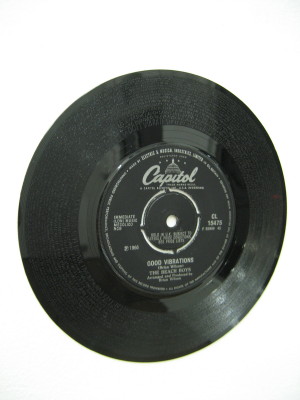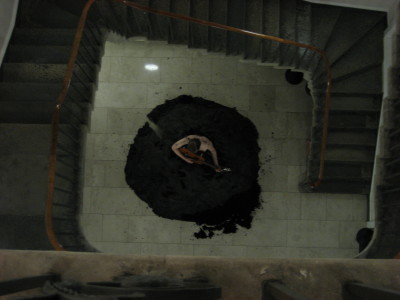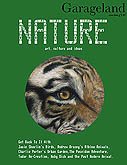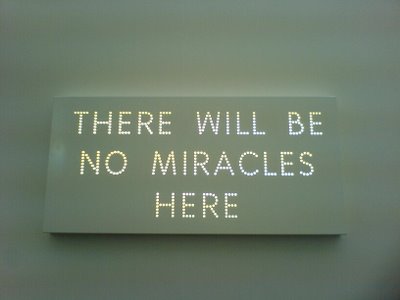 Rubbish (Part One)
Rubbish (Part One)
Tonight is a night of urban angst, from the dark, scary, litter strewn streets just outside your front door to the impending world ending global catastrophes of comets, earthquakes and tsunamis. In the
Rokeby Gallery Michael Samuels’ fantastical small sculptures is ratcheting up the quiet tension and fear you may be harbouring in the dark recesses of your mind. Samuels’ sculptures look like tiny architectural models created for a Bond villain or dark streetscapes left behind by the
little people.
Suspended from or atop small pieces of wooden tables and stools sit the tiny sculptures, on recognisable human environmental detritus of discarded furniture are smaller environments for what appears to be minituarised versions of ourselves.
These versions have departed the scenes and left a variety of street furniture and architectural objects behind them. Strung between two stools raised up on large impromptu stilts is a long precarious rope bridge over what would be an instant death drop, another scene shows a turquoise blue sea with a devils island decorated with large skulls sat in the middle of a calm, quiet and beautiful sea, a further seascape is interrupted by what appears to be large hole created by a world threatening comet hit.
In more domestic scenes is a street with a rubbish filled skip in another a discarded, overflowing, shopping trolley barely lit by a single street light, it seems to have been left in a hurry, the scene departed and just the trolley left as evidence that anyone was there. Most of the domestic environments on modified coffee tables give this appearance. One such environment is once again uninhabited but the sinister threat is more explicit with a police board appealing for witnesses.
In the parallel world of our tiny alter egos the sinister and threatening becomes more obvious than our own, for the tiny other me and you in Samuels’ imaginings the darkness and fear is a constant, inescapable part of the world he has constructed. In the downstairs gallery even a point of respite will not really afford true relief from the mini nightmare world, a long boardwalk would give us a view out to the sea and some chance for quiet reflection but somehow this piece of coastal architecture is unsettling. It is a little too dark and devoid of any people, its prodigious span is too much to contemplate, escape from this scene would be a huge feat.
Rubbish (Part Two)
I am entering the
Hauser & Wirth Coppermill building for
Christophe Buchel’s new installation, I ascend the stairs and turn the corner onto the landing and squeeze past the huge number of people and the zed beds lining the corridor. These upstairs rooms are of a quietly unsettling domestic nature, it looks like a dosshouse or cheap hotel for previously successful professional people who have retired and are quietly slipping into madness. In the first room I enter it appears one such retiree has collected a huge number of objects from a lifetime as an archeologist and is scattering the remnants around the room in an order only clear to himself. The cupboard in the room is open and I jump as one of my fellow visitors appears from the cupboard and leaps out into the room, on closer inspection they have emerged from the only access in and out of the room next door which is through a hole in the back of the cupboard and the hole in the wall that the cupboard sits in front of. Outside this the neighbouring room the door is padlocked from the outside. Other doors are padlocked and others are free to enter, one is a kitchen filled with people, no doubt they are visitors to the gallery like myself but the way they inhabit this room makes them seem part of the show, the mundane conversation and the appearance of the kitchen could be mock or real, possibly it is the territory between the two but I cant tell.
To my left is a toilet, the room is filled with pot plants, not quite like a jungle but perhaps an indoor forest of potted houseplants, luckily I am not feeling in need of the facilities and scuttle out onto the fire escape and descend into the chaos of the main gallery space.
Hauser & Wirth’s gallery space at Coppermill does not give the appearance of a normal gallery, in its previous incarnation it was a covered yard used for entirely practical reasons by the previous incumbents. H & W have decided to empty the yard and use it as they found it with no architectural interventions, but now with Buchel’s show it is refilled with “art”. This is not art as you might normally recognise it though, filled in a maniacal way with what can only be described as rubbish. This rubbish is not as it seems though, Buchel has created what I can best describe as a hellish London shanty town, to my right is a small townscape of discarded fridges and freezers piled on top of each other. Further into this scene of madness is a flat bed lorry with bunkbeds lining the inside.
At the back of the yard/gallery/shantytown is a filthy caravan, the inside looks inhabited by the untidiest person you can imagine, I peer in for a while and decide to stroll back into the main space, I am momentarily distracted by one guy animatedly shouting to his friend, “this is mad, this is madness, this is really mad, madness, really mad, really really mad,……” he is grinning and saying this over and over and over and
CRUNCH…., in my distraction I have just stepped on some ‘art’, it is a little piece of brittle black plastic and it had just toppled from the piles of ‘stuff’ that have been pushed and piled against the walls that surround the caravan and against the caravan itself. Piles of circuit boards from what must be thousands of defunct computers sit by the wall and against and around the caravan are a tower of white metal cases that the boards came from, a small path between the computer detritus snakes back into the main space, I walk the path between the cases and their neighbouring wires back into this nightmarish world.
Further on is a ‘porn room’, a large collection of people are standing in the room which is actually a shipping container opened up and lit inside, at every available piece of wall is a page or poster from various porn magazines, at every point I look at the walls a variety of young women look back whilst fingering their genitals and contorting their bodies in various positions, I look into this room/container from outside and notice that even with the huge numbers of visitors to this evenings opening this is by far the busiest room. I decide not to go inside this particular room, it emanates a hot, damp, muggy air that I can feel just standing a few yards from the entrance and the smell coming from the room is somewhat unsavoury.
Despite my slightly unsettled state surrounded by such chaos I enter one last space, I am attracted to it by the familiar comfortable sounds of football commentary, it is an empty canteen style room in a portacabin. Cheap, old tables and chairs are lined up in front of the small portable television sitting on a bracket on the wall, I watch for a short while as Manchester United play Bayern Munich in the Champions League.
Despite the comforting experience of televised football I need to leave, I cant figure out what is going on, this is urban angst in physical form, what is art?, what is rubbish?, are the gallery staff part of the installation?, are the visitors part of the installation?. There are many other dark corners and environments in Buchel’s installation that I have yet to sample but I am leaving anyway, all the edges are blurring into a mess and a mass and I feel like a unwitting participant in a horrible game, such is Buchel’s bizarre creation. The final act of this bizarre experience comes as I approach the stars of the main building to return to the real world, on these stairs when I arrived earlier I was greeted by an attractive member of the gallery staff. As I leave the same staff member appears from behind a closed door as if from nowhere just as I am passing and I jump, startled for the second time this evening by an unexpected appearance, this is of course not intentional, I am sure Buchel hasn’t engineered this just to give me a little scare as I leave, or has he?.











